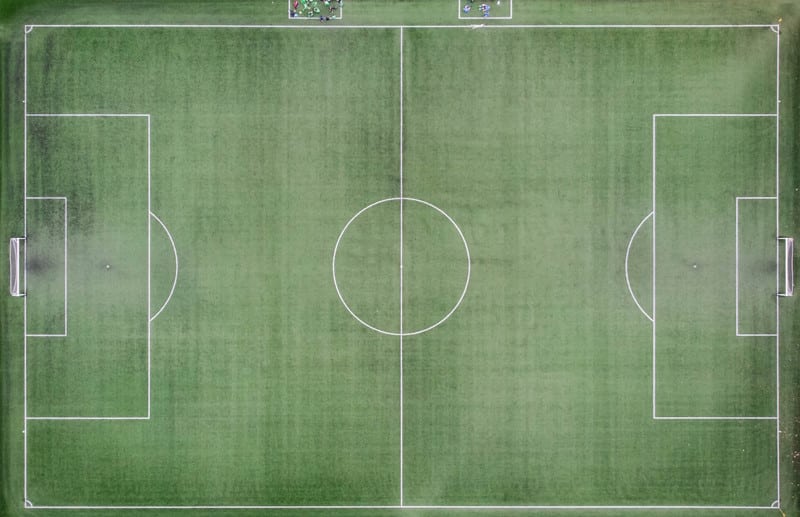How Long Is a Football Game?
A standard football match lasts 90 minutes, which is divided into two 45 minutes halves.
Though, it’s worth noting that the actual length of a football match can be longer than 90 minutes due to added time. A referee might add more time to make up for any time lost due to player injuries, substitutions, or other stoppages during the match.
In professional football games, the referee can add anything from 30 seconds to 5 minutes of added time to the end of each half – depending on the amount of time lost during that half. Sometimes the added time can be much longer, such as during injury delays.
Before 1886, there were no set rules for how long a football game should last, and matches could last for any length of time that was agreed by the teams.
It wasn’t until the International Football Association Board (IFAB) set the standard length of a football game to 90 minutes.
The 90-minute match length was based on the opinion of clubs and players at the time, who thought this was a suitable length for a match to be played. It has remained at 90 minutes ever since, although adjustments have allowed for injury time, extra time, and penalty shootouts in the event of a draw.
There are some differences, however, in the length of a football game. Some variations, such as futsal and indoor football, have shorter game times of around 40 minutes per match.
How Long Is Half-Time In Football?
Half-time in football matches lasts for 15 minutes. This is the standard length in most football competitions, including international matches, domestic league games, and cup competitions.
During half-time, the players leave the field and go back to their dressing rooms for a break, while the coaches and support staff may discuss tactics and change their team’s strategy.
Fans tend to use this time to go to the toilets or buy food and drink from the burger stalls. Once the 15-minute half-time is up, the teams return to the field to start the match’s second half.
The IFAB decided to have a half-time break during a football match to give players and officials some time to refresh. But it has not always been 15 minutes!
In 1970, the half-time break was extended to 20 minutes for the FIFA World Cup in Mexico, but it was reduced back to 15 minutes after the tournament finished.
How Long Is Extra Time In Football?
Extra time in football is 30 minutes, divided into two 15-minute halves. If a match ends in a draw after 90 minutes of play, and a winner needs to be decided, such as in a knockout competition or a playoff – then extra time is played.
It was in 1992 that the IFAB ruled that extra time should consist of two halves of 15 minutes each.
If the score still remains tied after 30 minutes of extra time, the referee will move on to “penalties”, so a winner can be settled. A penalty shootout involves each team (5 players are usually nominated from each) taking turns to shoot from the penalty spot.
Though, adding extra time was not universal across all football competitions!
In some knockout tournaments, such as the FA Cup, replays were used instead of extra time until relatively recently. In a replay, the entire match is played again on a different day, rather than using extra time or a penalty shootout to produce a winner.
Golden & Silver Goal Rules
There were also golden goal and silver goal rules used in football to determine the winner when a match ended in a draw after the first 90 minutes or extra time.
The golden goal rule states that if a team scores a goal during the extra time period, the match ends immediately, and that team is declared the winner. If no goals are scored during extra time, the game goes to penalties to see who wins the match.
The silver goal rule is similar to the golden goal rule but with a slight difference.
If a team scores a goal during the first half of extra time, the game continues until the end of the extra time, and if the leading team remains ahead, they are declared the winner. However, if the trailing team scores a goal during the second half of extra time, the game continues until the end of the extra time, and if the scores remain level, the game goes to penalties.
FIFA introduced both the golden goal and silver goal rules in the late 1990s as a way to encourage more attacking play and to prevent teams from playing for a draw.
However, they were only used for a short period and were eventually abolished due to criticism that they placed too much emphasis on luck and encouraged overly defensive tactics.
How Many Acres Is a Football Pitch?
The recommended football pitch for adults playing 11 v 11 is 110 yards long x 70 yards wide. So, this calculates a football pitch at 1.59 acres (110×70=7,700 / 4,840 = 1.59).

Various football organisations have standardised the size of a football pitch over time. In 1863, the FA was one of the first to standardise the rules and regulations of football, including pitch dimensions.
The FA stipulated that the length of the pitch should be between 100 and 130 yards (90-120 meters), and the width should be between 50 and 100 yards (45-90 meters). Other football organisations, such as FIFA, UEFA, and IFAB, have adopted these standardised pitch dimensions as well.
How Wide Is a Football Goal?
The FA have set the size and shape of the goalposts and crossbar. The distance between the posts is set at 8 yards (7.32 meters), and the crossbar height is set at 8 feet (2.44 meters).
These goal dimensions have remained essentially unchanged, although some variations are allowed within certain competitions and age groups.
When Does The Football Season Start & End?
Football season’s start and end dates vary depending on the country and the league. The football season generally starts in late summer and ends in spring of the following year.
For example, in England, the Premier League starts in mid-August and ends in mid-May, while the English Football League (EFL) and lower divisions start earlier and end later.
In Spain, La Liga begins in mid-August and ends in mid-May, while in Italy, Serie A starts in late August or early September and finally ends in May.
Keep in mind that international competitions such as the FIFA World Cup or the UEFA European Championship have their own schedules and do not follow the same calendar as domestic leagues.
Every league is different, but most seasons generally last around 9 to 10 months.
However, some leagues have a shorter season. For instance, the MLS (Major League Soccer) in the United States runs from March to October, while the A-League in Australia typically runs from October to May.
If you have enjoyed these fun football facts, please feel free to share them.
As you have been reading these facts, you might be interested in our other posts on:



